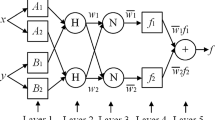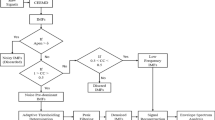Abstract
Multi-fault diagnosis for bearings is a challenge task. It is difficult to identify all the features from measured vibration signals when there is more than one bearing fault, especially, when some fault feature at the early stage is relatively weak and easily immersed in noise and other signals. The ensemble empirical mode decomposition (EEMD) method inherits the advantage of the popular empirical mode decomposition (EMD) method and can adaptively decompose a multi-component signal into a number of different bands of signal components called intrinsic mode functions (IMFs). In this chapter, the strategies of parameter optimization and signal component combination are combined with the normal EEMD to enhance its performance on signal processing. A vibration signal collected from a multi-fault bearing was used to verify the effectiveness of the enhanced EEMD method. The results demonstrate that the proposed method can accurately extract the feature signal; meanwhile, it makes the physical meaning of each IMF clear.
Access this chapter
Tax calculation will be finalised at checkout
Purchases are for personal use only
Similar content being viewed by others
References
Hajiaghajanim M, Toliyat HA (2004) Advanced fault diagnosis of a DC motor. IEEE Trans Energy Convers 19(1):60–65
Jiang H, Li C, Li H (2013) An improved EEMD with multi-wavelet packet for rotating machinery multi-fault diagnosis. Mech Syst Signal Process 36(2):225–239
Li Z, Yan X, Yuan C, Peng Z, Li L (2011) Virtual prototype and experimental research on gear multi-fault diagnosis using wavelet-autoregressive model and principal component analysis method. Mech Syst Signal Process 25(7):2589–2607
Tang X, Zhuang L, Cai J, Li C (2010) Multi-fault classification based on support vector machine trained by chaos particle swarm optimization. Knowl-Based Syst 23(5):486–490
Jing J, Meng G (2009) A novel method for multi-fault diagnosis of rotor system. Mech Machine Theory 44(4):697–709
Purushotham V, Narayanan S, Prasad SAN (2005) Multi-fault diagnosis of rolling bearing elements using wavelet analysis and hidden Markov model based fault recognition. NDT and E Int 38(8):654–664
Huang NE, Shen Z, Long R et al (1998) The empirical mode decomposition and the Hilbert spectrum for non-linear and non-stationary time series analysis. Proc Royal Soc London Ser A-Math Phys Eng Sci 1998:903–995
Huang NE, Shen Z, Long SR (1999) A new view of nonlinear water waves—the Hilbert spectrum. Ann Rev Fluid Mech 31:417–457
Feldman M (2009) Analytical basics of the EMD: Two harmonics decomposition. Mech Syst Signal Process 23(7):2059–2071
Wu Z, Huang NE (2009) Ensemble empirical mode decomposition: a noise-assisted data analysis method. Advan Adapt Data Anal 1(1):1–41
Lei Y, Zuo MJ (2009) Fault diagnosis of rotating machinery using an improved HHT based on EEMD and sensitive IMFs. Measure Sci Technol 20(12):125701 (12 pp)
Lei Y, He Z, Zi Y (2011) EEMD method and WNN for fault diagnosis of locomotive roller bearings. Expert Syst Appl 38(6):7334–7341
Lei Y, He Z, Zi Y (2009) Application of the EEMD method to rotor fault diagnosis of rotating machinery. Mech Syst Signal Process 23(4):1327–1338
Zhou Y, Tao T, Mei X, Jiang G, Sun N (2011) Feed-axis gearbox condition monitoring using built-in position sensors and EEMD method. Robot Comput-Integr Manufact 27(4):785–793
Žvokelj M, Zupan S, Prebil I (2011) Non-linear multivariate and multiscale monitoring and signal denoising strategy using Kernel Principal Component Analysis combined with Ensemble Empirical Mode Decomposition method. Mech Syst Signal Process 25(7):2631–2653
Žvokelj M, Zupan S, Prebil I (2010) Multivariate and multiscale monitoring of large-size low-speed bearings using Ensemble Empirical Mode Decomposition method combined with Principal Component Analysis. Mech Syst Signal Process 24(4):1049–1067
Chang KM, Liu SH (2011) Gaussian noise filtering from ECG by Wiener filter and ensemble empirical mode decomposition. J Signal Process 64(2):249–264
Zhang J, Yan R, Gao RX, Feng Z (2010) Performance enhancement of ensemble empirical mode decomposition. Mech Syst Signal Process 24(7):2104–2123
Yeh JR, Shieh JS, Huang NE (2010) Complementary ensemble empirical mode decomposition: a novel noise enhanced data analysis method. Advan Adapt Data Analy 2(2):135–156
Niazy RK, Beckmann CF, Brady JM, Smith SM (2009) Performance evaluation of ensemble empirical mode decomposition. Advan Adapt Data Analy 1(2):231–242
Guo W, Tse PW (2013) A novel signal compression method based on optimal ensemble empirical mode decomposition for bearing vibration signals. J Sound Vibrat 332(2):423–441
Antoni J (2007) Cyclic spectral analysis in practice. Mech Syst Signal Process 21(2):597–630
Guo W, Tse PW, Djordjevich A (2012) Faulty bearing signal recovery from large noise using a hybrid method based on spectral kurtosis and ensemble empirical mode decomposition. Measurement 45(5):1308–1322
Acknowledgment
The work that is described in this chapter is fully supported by the Fundamental Research Funds for the Central Universities (Project No. ZYGX2012J105 and Project No. ZYGX2013J094). The authors wish to thank Dr. Peter W. Tse in City University of Hong Kong for the allowance of using experimental bearing data. We appreciate three anonymous reviewers for their valuable comments and suggestions for improving this chapter.
Author information
Authors and Affiliations
Corresponding author
Editor information
Editors and Affiliations
Rights and permissions
Copyright information
© 2015 Springer International Publishing Switzerland
About this paper
Cite this paper
Guo, W., Wang, K.S., Wang, D., Tse, P.W. (2015). Feature Signal Extraction Based on Ensemble Empirical Mode Decomposition for Multi-fault Bearings. In: Tse, P., Mathew, J., Wong, K., Lam, R., Ko, C. (eds) Engineering Asset Management - Systems, Professional Practices and Certification. Lecture Notes in Mechanical Engineering. Springer, Cham. https://doi.org/10.1007/978-3-319-09507-3_113
Download citation
DOI: https://doi.org/10.1007/978-3-319-09507-3_113
Published:
Publisher Name: Springer, Cham
Print ISBN: 978-3-319-09506-6
Online ISBN: 978-3-319-09507-3
eBook Packages: EngineeringEngineering (R0)




